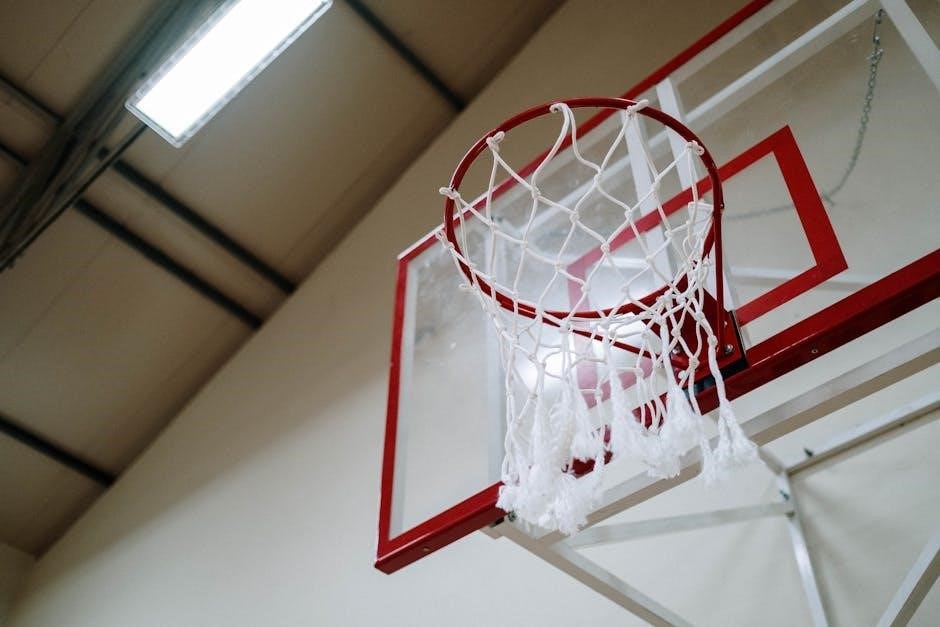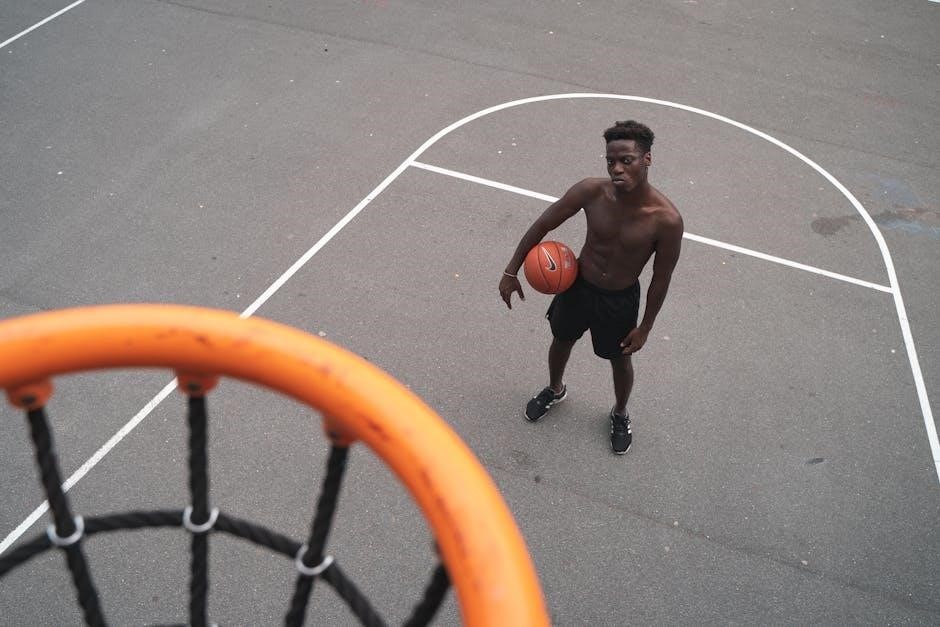Manual High School Basketball: A Comprehensive Guide
This comprehensive guide delves into the intricacies of high school basketball, covering NFHS rules, guidelines, and interpretations. It aims to educate coaches, players, and officials, promoting fair play and sportsmanship. Explore rule changes, technical fouls, free throw procedures, and equipment regulations for a complete understanding.

High school basketball serves as a foundational platform for aspiring athletes, instilling discipline, teamwork, and sportsmanship. It provides a structured environment where young players can develop their skills, learn the fundamentals of the game, and compete at a higher level. This introduction explores the significance of high school basketball, emphasizing its role in shaping character and fostering a love for the sport.
Beyond the court, high school basketball cultivates essential life skills, such as time management, leadership, and resilience. Players learn to balance academic responsibilities with athletic commitments, fostering a strong work ethic. The camaraderie formed within a team environment promotes collaboration and communication, preparing individuals for future success in various aspects of life.
Furthermore, high school basketball provides opportunities for personal growth and self-discovery. Players learn to overcome challenges, persevere through adversity, and celebrate achievements together. The experience of competing under pressure builds confidence and enhances decision-making abilities, valuable assets that extend far beyond the basketball court. This guide will cover all aspects to help players, coaches, and referees.
NFHS Basketball Rules and Guidelines
The National Federation of State High School Associations (NFHS) establishes the standard rules and guidelines governing high school basketball in the United States. These regulations ensure fair play, promote player safety, and maintain the integrity of the game. Understanding the NFHS rule book is crucial for coaches, players, and officials to navigate the complexities of high school basketball effectively.
The NFHS rule book covers a wide range of topics, including player eligibility, game conduct, fouls, violations, and scoring. It provides detailed explanations of each rule, accompanied by interpretations and case studies to clarify specific situations. By adhering to these rules, high school basketball programs can create a level playing field and foster a positive competitive environment.
Furthermore, the NFHS guidelines address issues such as sportsmanship, ethical conduct, and risk management. These principles emphasize the importance of respect, integrity, and fair play in all aspects of high school basketball. By promoting these values, the NFHS aims to instill character and leadership skills in young athletes, preparing them for success both on and off the court. The NFHS also provides resources for digital rules.
Key Rule Changes for 2024-2025 Season
Each year, the NFHS reviews and updates its basketball rules to address emerging trends, clarify existing regulations, and enhance the overall quality of the game. The 2024-2025 season brings several key rule changes that coaches, players, and officials must understand to ensure compliance and maintain a fair competitive environment. These changes are designed to improve player safety, promote sportsmanship, and enhance the flow of the game.
One notable change involves a new definition and warning regarding faking being fouled, also known as “flopping.” This rule aims to discourage players from exaggerating contact to draw fouls, promoting a more honest and sportsmanlike approach to the game. Another adjustment allows 20 seconds for a player to address minor bleeding without leaving the game, streamlining the process and minimizing disruptions. These changes reflect the NFHS’s commitment to adapting the rules to address current issues and improve the overall experience of high school basketball.

Staying informed about these rule changes is crucial for all participants in high school basketball. Coaches should educate their players on the new regulations and incorporate them into their training strategies. Officials must thoroughly understand the changes to ensure consistent and accurate enforcement during games.
Commonly Misunderstood Rules in High School Basketball
Despite the seemingly straightforward nature of basketball, several rules are frequently misinterpreted or misunderstood, leading to confusion among players, coaches, and even spectators. Clarifying these ambiguities is crucial for ensuring fair play and promoting a better understanding of the game.
One common misconception revolves around the 3-second rule. It’s often believed that a 3-second count restarts upon the release of a shot, which is incorrect. The count only stops when a player is no longer in the lane. Another area of confusion involves traveling violations during throw-ins. It’s impossible to travel, double dribble, or carry the ball during a throw-in. Many also misunderstand the closely guarded rule, especially with the presence of a shot clock. Players may mistakenly believe that the closely guarded rule is not in effect when a shot clock is in use. A high dribble is legal as long as the hand is on top of the ball.
These are just a few examples of the many rules that can be easily misinterpreted. By addressing these common misunderstandings, we can foster a more informed and equitable environment for all involved in high school basketball.
Technical Fouls: Definition and Examples
In high school basketball, a technical foul is a non-contact foul that is assessed for unsportsmanlike conduct or for specific administrative infractions. Unlike personal fouls, which involve illegal physical contact, technical fouls address actions detrimental to the game’s integrity. Understanding the nuances of technical fouls is crucial for players, coaches, and officials alike.
The NFHS defines a technical foul as any action by a player or coach that brings the game into disrepute. This broad definition encompasses a range of behaviors, including disrespectful communication with officials, using profane language, taunting opponents, or delaying the game. Examples include a coach entering the court without permission, a player using excessive gestures, or any act deemed flagrantly unsportsmanlike. Furthermore, administrative technical fouls can be issued for uniform violations or failing to provide the scorer with the correct lineup.
When a technical foul is assessed, the opposing team is awarded two free throws and possession of the ball at the center court line. Repeated or egregious technical fouls can lead to ejection from the game. Maintaining composure and adhering to the spirit of the game are paramount to avoiding these penalties.
Free Throw Procedures and Foul Administration
Free throws are a critical aspect of high school basketball, offering unguarded opportunities to score. The procedures surrounding free throws and the administration of fouls are governed by specific rules outlined by the NFHS. A clear understanding of these regulations is essential for players, coaches, and officials to ensure fair and accurate gameplay.
When a player is fouled while shooting or under certain other circumstances, they are awarded free throws. The number of free throws awarded depends on the type of foul and whether the shot was made. The player must shoot from behind the free-throw line, within the designated semicircle. Players are allowed a certain amount of time to attempt the free throw after the official places the ball at their disposal.
Foul administration involves accurately recording fouls committed by each player and team. A player is disqualified from the game after accumulating five personal fouls. Team fouls are also tracked, and once a team reaches a designated number of fouls in a period, the opposing team enters the bonus, awarding them free throws for each subsequent common foul. Proper foul administration ensures the integrity of the game and prevents unfair advantages.
Closely Guarded Rule and Shot Clock Considerations
The closely guarded rule and the shot clock, when implemented, significantly impact the offensive and defensive strategies in high school basketball. The closely guarded rule aims to prevent excessive stalling by a player holding the ball without attempting to advance or score. It dictates that a player in possession of the ball cannot be closely guarded for more than five seconds while in their team’s frontcourt.
The shot clock, used in some states, introduces a time limit for a team to attempt a shot at the basket. Typically, the shot clock is set at 35 seconds. If a team fails to shoot and hit the rim or enter the basket within the allotted time, a shot clock violation is called, and possession is awarded to the opposing team. The shot clock encourages a faster pace of play and prevents teams from holding the ball for extended periods;
The implementation of a shot clock often influences how strictly the closely guarded rule is enforced. In states with a shot clock, officials may be more lenient with the closely guarded rule because the shot clock already prevents excessive stalling. Together, these rules contribute to a more dynamic and engaging game for players and spectators.
Coaching Box Rules and Regulations
The coaching box in high school basketball defines the area within which the head coach and other authorized team personnel are permitted to stand and move during the game. NFHS rules specify the dimensions and location of this designated area, usually marked along the sideline in front of the team bench. Only the head coach is typically allowed to stand within the coaching box, while assistant coaches and other team members must remain seated on the bench unless specifically authorized to address an injury or other specific situation.

Coaches are expected to remain primarily within the coaching box during live play to avoid interfering with the game or encroaching onto the court. They can move within the box to communicate with players, address officials, or manage their team. However, they cannot leave the coaching box to argue excessively with officials or engage in unsportsmanlike conduct. Penalties for violating coaching box rules can range from warnings to technical fouls assessed against the coach or the team.
The coaching box helps maintain order on the sidelines, limits distractions for players, and ensures that coaches conduct themselves professionally. It provides a defined space for coaching activities while preventing interference with the flow of the game.
Officials: Rating and Incident Reporting

High school basketball officials play a crucial role in ensuring fair play and maintaining the integrity of the game. Their performance is often evaluated through rating systems designed to provide feedback and promote continuous improvement. Rating cards, typically filled out by coaches or designated observers, assess officials’ knowledge of the rules, their ability to manage the game effectively, and their overall demeanor. These ratings contribute to an official’s professional development and can influence their assignments for future games.
In addition to performance ratings, officials are responsible for reporting any significant incidents that occur during a game. This includes ejections of players or coaches, forfeits due to unsportsmanlike conduct, and any notable injuries. Incident reports provide a detailed account of the event, including the individuals involved, the circumstances leading up to the incident, and the actions taken by the officials. These reports are essential for maintaining accurate records and addressing any disciplinary issues that may arise.
Furthermore, officials may also be required to submit reports on sportsmanship feedback, documenting the behavior of players, coaches, and spectators. This helps identify any patterns of unsportsmanlike conduct and allows for appropriate interventions to promote a positive and respectful environment for high school basketball.
Sportsmanship Expectations for Players and Coaches
In high school basketball, sportsmanship is paramount, extending beyond mere adherence to rules. It encompasses ethical behavior, respect for opponents, officials, and the game itself. Players are expected to demonstrate integrity, avoid taunting or disrespectful gestures, and accept decisions with grace, win or lose. Coaches are role models, tasked with instilling these values, promoting fair play, and maintaining composure on the sidelines. They guide players in handling both victory and defeat with dignity.
Displays of anger, dissent, or unsportsmanlike conduct are unacceptable. Mimicking shooting actions or other provocative celebrations are prohibited. Coaches must ensure their players understand and abide by these expectations. Positive interactions between teams, respectful communication with officials, and gracious acknowledgment of opponents’ efforts contribute to a positive atmosphere. Sportsmanship fosters a healthy competitive environment, allowing young athletes to develop character, learn valuable life lessons, and appreciate the true spirit of the game.
Schools often have feedback mechanisms to address sportsmanship concerns, promoting accountability and reinforcing the importance of ethical behavior. By prioritizing sportsmanship, high school basketball programs can cultivate a culture of respect, integrity, and fair play, enriching the experience for all involved.
Equipment Regulations: Ball Size and Basket Height
High school basketball adheres to specific equipment regulations to ensure fair play and consistent standards. These regulations primarily concern ball size and basket height, crucial elements influencing gameplay. According to NFHS guidelines, the official ball size differs between girls’ and boys’ basketball. Girls’ basketball utilizes a ball with a circumference of 28.5 inches, while boys’ basketball employs a slightly larger ball with a circumference of 29.5 inches. This distinction accommodates the varying hand sizes and physical attributes of male and female athletes, optimizing ball control and shooting accuracy.
Basket height is standardized at 10 feet for both girls’ and boys’ high school basketball. This consistent height provides a uniform challenge for players regardless of gender, emphasizing skill, technique, and athleticism. Maintaining the correct ball size and basket height is essential for creating a level playing field and promoting fair competition. Officials are responsible for verifying that all equipment meets these specifications before each game. Any deviations from these standards can affect the game’s integrity and should be addressed promptly. Compliance with equipment regulations demonstrates a commitment to fairness and ensures a positive experience for all participants.
Residency Rules and Consequences for Violations
High school athletic associations, including the NFHS, establish residency rules to ensure fair competition and prevent the recruitment of players. These rules typically require student-athletes to reside within a specific geographic area, usually the school district or attendance zone, to be eligible to participate in sports. The purpose is to maintain a level playing field and prevent schools from gaining an unfair advantage by attracting talented athletes from outside their designated area. Residency rules can be complex and vary by state, often involving documentation such as proof of address, parental custody arrangements, and previous school enrollment records.
Violations of residency rules can lead to serious consequences for both the student-athlete and the school. If a player is found to be ineligible due to a residency violation, they may be suspended from participating in games or even face expulsion from the team. The school may also face penalties, including forfeiting games in which the ineligible player participated, being fined, or facing sanctions from the athletic association. In some cases, coaches or administrators may also be held accountable for knowingly violating residency rules. Strict enforcement of these rules is crucial for maintaining the integrity of high school sports and ensuring that all schools have an equal opportunity to compete.

